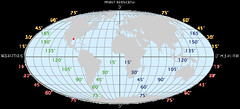From WorldAtlas.com:
Latitude (shown as a horizontal line) is the angular distance, in degrees, minutes, and seconds of a point north or south of the Equator. Lines of latitude are often referred to as parallels.
Longitude (shown as a vertical line) is the angular distance, in degrees, minutes, and seconds, of a point east or west of the Prime (Greenwich) Meridian. Lines of longitude are often referred to as meridians.
Distance between Lines If you divide the circumference of the earth (approximately 25,000 miles) by 360 degrees, the distance on the earth's surface for each one degree of latitude or longitude is just over 69 miles, or 111 km. Note: As you move north or south of the equator, the distance between the lines of longitude gets shorter until they actually meet at the poles. At 45 degrees N or S of the equator, one degree of longitude is about 49 miles.
skip to main |
skip to sidebar
For students and parents who love education and exploration of the social sciences . . .
Search This Blog
Followers
Blog Archive
-
▼
2009
(379)
-
▼
August
(38)
- This week's music in World Geography: early jazz f...
- Graphing US demographics: ethnic breakdown
- The background of place names such as York
- River studies: journey up the Hudson with a NY Tim...
- A highly-recommended source for Magnet social stud...
- Project due Tues, Sept 8: Comparing the Erie Canal...
- Water giveth, water taketh away: week of Aug 31 to...
- Water and wealth: the story of the Erie Canal
- Matterhorn: The Alps IMAX film opening September 5...
- Longitude: what if the GPS satellite is out of com...
- A suburb of London called Greenwich, England: Lati...
- The Hydrologic cycle: condensation, precipitation,...
- Rivers equal wealth
- Ramadan: across the globe, one billion people are ...
- Latitude & Longitude: a review of the geography cl...
- Pratt Industries paper recycling plant on the Red ...
- The culture of the Miss River valley: Raising Cane...
- When a project or an essay is due via Google Docs ...
- A slow-moving internet: the Mississippi River and ...
- Preventing unwanted bleeding: the rubric for essay...
- Choctaws: one of the Native American tribes that m...
- Mr Mimal, mnemonics and map quizzes
- Discriminating between the avocado that needs more...
- From Minnesota to the Gulf of Mexico: the Mississi...
- Thirsty issues in your future: water supplies and ...
- Parent signature to show awareness of Mondotrudeau...
- The value in geography class is not in the facts
- An overview of Trudeau's world geography class in ...
- Your questions and input are valued in World Geogr...
- Personal computer classroom policy
- Typical Open Notes quiz: Obama biography
- Geography class homework: reading the notes posted...
- Scrumptious to bizarre: Comparison essay guidelines
- Establishing a gmail.com account for submitting pa...
- World geography / Robert Trudeau / materials 09 - 10
- Geography class syllabus / unit schedule 09 - 10
- Caddo Schools' calendar for 09-10
- LSUS Animation & Visual Effects open house Mon, Au...
-
▼
August
(38)

